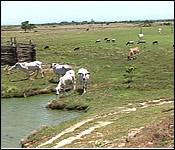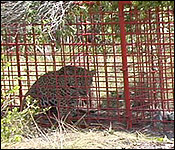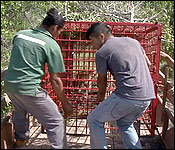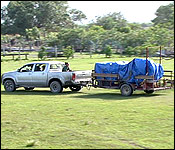


 Yesterday we told you about a problem jaguar that was caught in the Northern Lagoon area in the Belize District. The farm owners held the cat long enough for the Forest Department to extract the jaguar, and deliver it to the Belize Zoo for rehabilitation. However, once there, things did not go quite as expected. Alex Courtenay reports on the terrible twist in this jaguar's tale.
Yesterday we told you about a problem jaguar that was caught in the Northern Lagoon area in the Belize District. The farm owners held the cat long enough for the Forest Department to extract the jaguar, and deliver it to the Belize Zoo for rehabilitation. However, once there, things did not go quite as expected. Alex Courtenay reports on the terrible twist in this jaguar's tale.
Alex Courtenay reporting
Over the last few months, this farm in the Northern Lagoon area has served as a hunting grounds for a mature, male jaguar. According to the farm's owner, dozens of sheep, cows and geese have gone missing since the predator set up shop.
In an attempt to stop the jaguar from feasting on the livestock, a trap was set up on the outskirts of the farm, and after three days, the jaguar was caught. The Forest Department and Belize Zoo were then called to the scene to extract the problem animal.
Shanelly Carillo - Jaguar Officer, Forest Department
 "Well these situations aren't something very common and each situation is very unique, so there are different things that needs to be considered. In this situation what we tried to do one of the most important things is try to get the animal out of the area as soon as possible, just to reduce the stress and the possibility of any harm coming to the animal. As well we do not want it to stay in the farm with all the animals around. So that's the most important thing for extractions, but it's not something that's very common."
"Well these situations aren't something very common and each situation is very unique, so there are different things that needs to be considered. In this situation what we tried to do one of the most important things is try to get the animal out of the area as soon as possible, just to reduce the stress and the possibility of any harm coming to the animal. As well we do not want it to stay in the farm with all the animals around. So that's the most important thing for extractions, but it's not something that's very common."
As Carillo mentioned, situations like these are quite rare. It's not often that a jaguar wanders into a farm, and it's even less common that the jaguar is caught by the farmers, and the Forest Department is actually called in to intervene. Actually, in most cases, problem cats are hunted and killed. But, that's illegal and in cases like this one, it is recommended that farmers seek assistance as soon as possible.
Shanelly Carillo - Jaguar Officer, Forest Department
"First of all they need to contact the Forest Department as soon as possible and that's very important, because if the animal is not used to seeing domestic animals as a source of food, we can try to make it move away from the farm and just feed on the natural wild prey. So contact the Forest Department. We have a lot of advice that we can give to farmers and how to properly manage their animals and ensure that jaguars do not feed on the domesticated animals. That's the first step. From there we can try different things to make sure that the farm is safer and that jaguar stay outside of the farms and the domestic animals are safe inside the farm which is very important. We need to make sure that the jaguars can still move around in Belize, have healthy populations, but not causing problems to the farmers and their animals."
Because the jaguar caught at Northern Lagoon became so used to feeding off farm animals, relocating it into the wild would have been ineffective, and chances are he would have made his way right back to the farm. So, he was taken to the Belize Zoo, to join over a dozen other problem jaguars in a rehabilitation program. Unfortunately, when he arrived at the zoo, things took a turn for the worse.
Dr. George Kollias - Professor of Wildlife Medicine, Cornell University
 "When we observed him yesterday before we transported him, to me he looked like a very stress jaguar, he was breathing very heavily and his body temperature was probably quite high, so trying to cover him up and keep him out of the sun during transport was important and we observed him while being transported, he seem quite but not terribly distressed. When we arrived at the zoo, to me he looked more distressed and inactive. I was very concern about doing any kind of exam on him at that time, because to examine a jaguar they have to be anesthetized and even with healthy animals anesthesia is some risk, I felt it would be very risky and might die if we anesthetized him."
"When we observed him yesterday before we transported him, to me he looked like a very stress jaguar, he was breathing very heavily and his body temperature was probably quite high, so trying to cover him up and keep him out of the sun during transport was important and we observed him while being transported, he seem quite but not terribly distressed. When we arrived at the zoo, to me he looked more distressed and inactive. I was very concern about doing any kind of exam on him at that time, because to examine a jaguar they have to be anesthetized and even with healthy animals anesthesia is some risk, I felt it would be very risky and might die if we anesthetized him."
So far the experts can't say for sure, how the stress of being relocated contributed to the jaguar's death, but Dr. Kollias had a few theories.
Dr. George Kollias - Professor of Wildlife Medicine, Cornell University
"Well one scenario here is that he was in the capture cage we don't know for exact time period and normally many wild animals once they are captured and in a confine space they will try to escape. It was in an area very hot and humid and so he may have spent time trying to escape from the enclosure and during that process it causes a lot of damage to the large muscles and he is using during that process and his body temperature goes way up. That kind of sets up for a process for a specific type of shock to occur which is called hemorrhagic shock where the animals actually bleeds internally and dies."
The post-mortem on the jaguar's body also revealed that he was in near-perfect physical condition, so factors like disease and previous injuries have been ruled out for the most part. Now, the experts want to use this experience to make sure that no other animal suffers a similar fate.
Dr. George Kollias
"As they say 20/20 hindsight is always easy. Probably the only thing that really could be done to prevent this in the future I think that probably the most important thing we can discuss here is to monitor the trap very frequently even if has to be done at a distance with binoculars and soon as the animal is trap, planning on transport immediately if the weather conditions are good. The sooner the better."
Had the jaguar survived, his size and physical condition would have made him a prime candidate for display.



